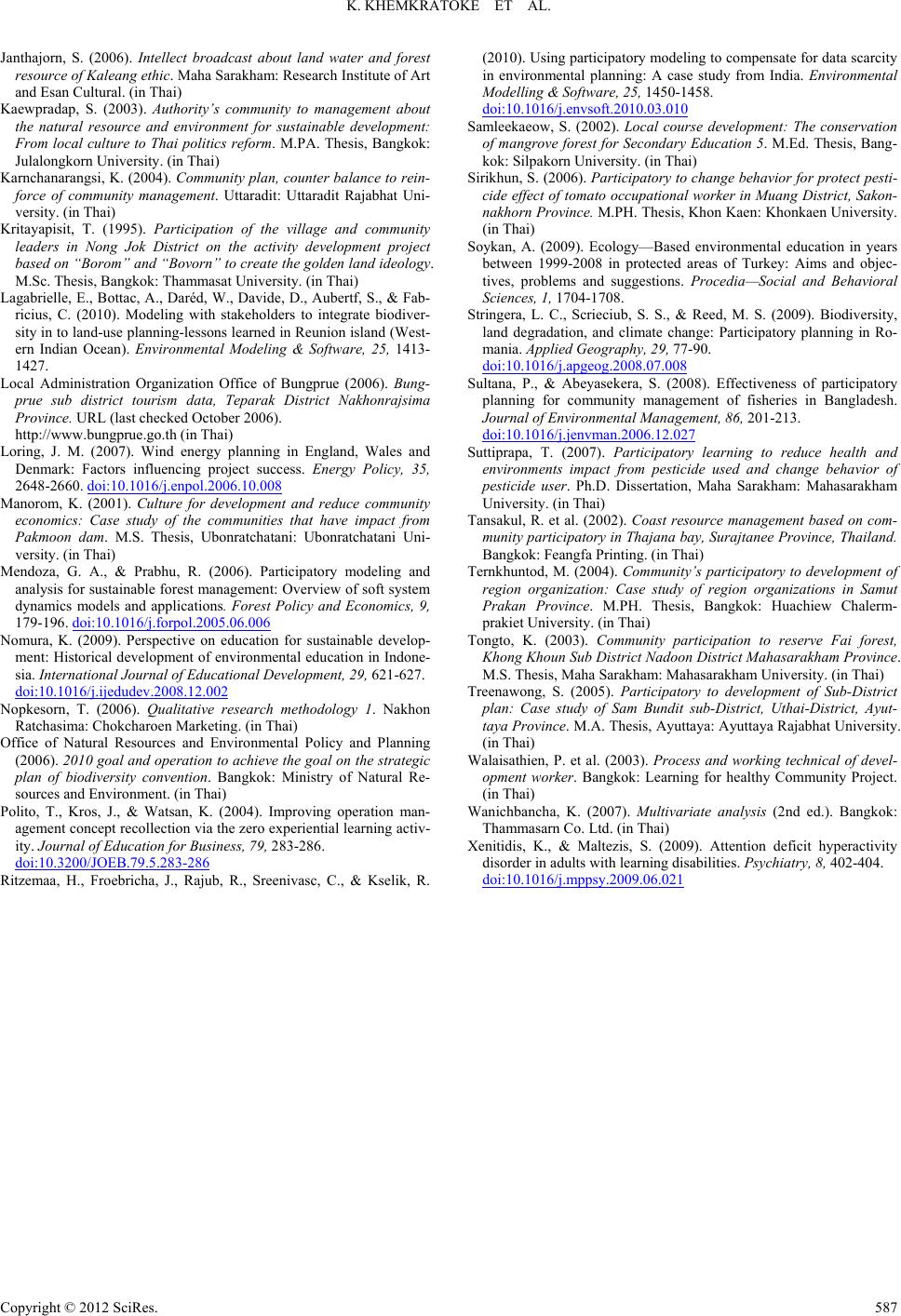
K. KHEMKRATOKE ET AL.
Janthajorn, S. (2006). Intellect broadcast about land water and forest
resource of Kaleang ethic. Maha Sarakham: Research Institute of Art
and Esan Cultural. (in Thai)
Kaewpradap, S. (2003). Authority’s community to management about
the natural resource and environment for sustainable development:
From local culture to Thai politics reform. M.PA. Thesis, Bangkok:
Julalongkorn University. (in Thai)
Karnchanarangsi, K. (2004). Community plan, counter balance to rein-
force of community management. Uttaradit: Uttaradit Rajabhat Uni-
versity. (in Thai)
Kritayapisit, T. (1995). Participation of the village and community
leaders in Nong Jok District on the activity development project
based on “Borom” and “Bovorn” to create the golden land ideology.
M.Sc. Thesis, Bangkok: Thammasat University. (in Thai)
Lagabrielle, E., Bottac, A., Daréd, W., Davide, D., Aubertf, S., & Fab-
ricius, C. (2010). Modeling with stakeholders to integrate biodiver-
sity in to land-use planning-lessons learned in Reunion island (West-
ern Indian Ocean). Environmental Modeling & Software, 25, 1413-
1427.
Local Administration Organization Office of Bungprue (2006). Bung-
prue sub district tourism data, Teparak District Nakhonrajsima
Province. URL (last checked October 2006).
http://www.bungprue.go.th (in Thai)
Loring, J. M. (2007). Wind energy planning in England, Wales and
Denmark: Factors influencing project success. Energy Policy, 35,
2648-2660. doi:10.1016/j.enpol.2006.10.008
Manorom, K. (2001). Culture for development and reduce community
economics: Case study of the communities that have impact from
Pakmoon dam. M.S. Thesis, Ubonratchatani: Ubonratchatani Uni-
versity. (in Thai)
Mendoza, G. A., & Prabhu, R. (2006). Participatory modeling and
analysis for sustainable forest management: Overview of soft system
dynamics models and applications. Forest Policy and Economics, 9,
179-196. doi:10.1016/j.forpol.2005.06.006
Nomura, K. (2009). Perspective on education for sustainable develop-
ment: Historical development of environmental education in Indone-
sia. International Journal of Educational Development, 29, 621-627.
doi:10.1016/j.ijedudev.2008.12.002
Nopkesorn, T. (2006). Qualitative research methodology 1. Nakhon
Ratchasima: Chokcharoen Marketing. (in Thai)
Office of Natural Resources and Environmental Policy and Planning
(2006). 2010 goal and operation to achieve the goal on the strategic
plan of biodiversity convention. Bangkok: Ministry of Natural Re-
sources and Environment. (in Thai)
Polito, T., Kros, J., & Watsan, K. (2004). Improving operation man-
agement concept recollection via the zero experiential learning activ-
ity. Journal of Education for Busin e s s, 79, 283-286.
doi:10.3200/JOEB.79.5.283-286
Ritzemaa, H., Froebricha, J., Rajub, R., Sreenivasc, C., & Kselik, R.
(2010). Using participatory modeling to compensate for data scarcity
in environmental planning: A case study from India. Environmental
Modelling & Software, 2 5 , 1450-1458.
doi:10.1016/j.envsoft.2010.03.010
Samleekaeow, S. (2002). Local course development: The conservation
of mangrove forest for Secondary Education 5. M.Ed. Thesis, Bang-
kok: Silpakorn University. (in Thai)
Sirikhun, S. (2006). Participatory to change behavior for protect pesti-
cide effect of tomato occupational worker in Muang District, Sakon-
nakhorn Province. M.PH. Thesis, Khon Kaen: Khonkaen University.
(in Thai)
Soykan, A. (2009). Ecology—Based environmental education in years
between 1999-2008 in protected areas of Turkey: Aims and objec-
tives, problems and suggestions. Procedia—Social and Behavioral
Sciences, 1, 1704-1708.
Stringera, L. C., Scrieciub, S. S., & Reed, M. S. (2009). Biodiversity,
land degradation, and climate change: Participatory planning in Ro-
mania. Applied Geography, 29, 77-90.
doi:10.1016/j.apgeog.2008.07.008
Sultana, P., & Abeyasekera, S. (2008). Effectiveness of participatory
planning for community management of fisheries in Bangladesh.
Journal of Environm e ntal Management, 86, 201-213.
doi:10.1016/j.jenvman.2006.12.027
Suttiprapa, T. (2007). Participatory learning to reduce health and
environments impact from pesticide used and change behavior of
pesticide user. Ph.D. Dissertation, Maha Sarakham: Mahasarakham
University. (in Thai)
Tansakul, R. et al. (2002). Coast resource management based on com-
munity participatory in Thajana bay, Surajtanee Province, Thailand.
Bangkok: Feangfa Printing. (in Thai)
Ternkhuntod, M. (2004). Community’s participatory to development of
region organization: Case study of region organizations in Samut
Prakan Province. M.PH. Thesis, Bangkok: Huachiew Chalerm-
prakiet University. (in Thai)
Tongto, K. (2003). Community participation to reserve Fai forest,
Khong Khoun Sub District Nadoon District Mahasarakham Province.
M.S. Thesis, Maha Sarakham: Mahasarakham University. (in Thai)
Treenawong, S. (2005). Participatory to development of Sub-District
plan: Case study of Sam Bundit sub-District, Uthai-District, Ayut-
taya Province. M.A. Thesis, Ayuttaya: Ayuttaya Rajabhat University.
(in Thai)
Walaisathien, P. et al. (2003). Process and working technical of devel-
opment worker. Bangkok: Learning for healthy Community Project.
(in Thai)
Wanichbancha, K. (2007). Multivariate analysis (2nd ed.). Bangkok:
Thammasarn Co. Ltd. (in Thai)
Xenitidis, K., & Maltezis, S. (2009). Attention deficit hyperactivity
disorder in adults with learning disabilities. Psychiatry, 8, 402-404.
doi:10.1016/j.mppsy.2009.06.021
Copyright © 2012 SciRes. 587